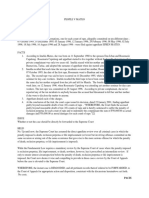0 ratings0% found this document useful (0 votes)
572 viewsPart II: A Stakeholder Perspective Chapter 3: Stakeholder Theory
The document discusses stakeholder theory and defines stakeholders. It provides multiple definitions of stakeholders and proposes a new definition. It also discusses identifying and prioritizing among stakeholders and issues.
Uploaded by
Jesslyn WongCopyright
© © All Rights Reserved
Available Formats
Download as PDF, TXT or read online on Scribd
0 ratings0% found this document useful (0 votes)
572 viewsPart II: A Stakeholder Perspective Chapter 3: Stakeholder Theory
The document discusses stakeholder theory and defines stakeholders. It provides multiple definitions of stakeholders and proposes a new definition. It also discusses identifying and prioritizing among stakeholders and issues.
Uploaded by
Jesslyn WongCopyright
© © All Rights Reserved
Available Formats
Download as PDF, TXT or read online on Scribd
You are on page 1/ 17
Part II: A Stakeholder Perspective
Chapter 3: Stakeholder Theory
1. Definitions of a Stakeholder
“Stakeholders in an organization are the individuals and groups
who are depending on the firm in order to achieve their personal
goals and on whom the firm is depending for its existence.”
—Eric Rhenman (1964)
“The stakeholders in a firm are individuals and constituencies
that contribute, either voluntarily or involuntarily, to its wealth-
creating capacity and activities, and who are therefore its
potential beneficiaries and/or risk bearers.”
—Post, Preston, and Sachs (2002)
Chandler, Strategic Corporate Social Responsibility,
2
5e. © SAGE Publishing, 2020
Chandler, Strategic Corporate Social Responsibility, 5e. ©
3
SAGE Publishing, 2020
3. A New Definition of a Stakeholder
An individual or organization that is affected by the firm
(either voluntarily or involuntarily), and possesses
the capacity and intent to affect the organization.
Chandler, Strategic Corporate Social Responsibility,
4
5e. © SAGE Publishing, 2020
4. Is the Environment a Stakeholder?
An argument for including the environment as one of
the firm’s societal stakeholders is to reinforce the
importance of sustainability within the CSR debate,
while recognizing that the environment requires actors
to speak and act on its behalf in order to be protected.
In Figure 3.1, however, the environment is excluded due
to its lack of agency. Since the environment is unable to
speak for itself, the manager’s priority (in relation to
sustainability issues) should be to attend to those
stakeholders who speak most vigorously (and
knowledgeably) on the environment’s behalf.
Chandler, Strategic Corporate Social Responsibility,
5
5e. © SAGE Publishing, 2020
5. Concentric Circles of Stakeholders
Chandler, Strategic Corporate Social Responsibility,
6
5e. © SAGE Publishing, 2020
6. Prioritizing Stakeholders
• Stakeholders can be divided into three categories:
Organizational stakeholders:
For example, employees, managers, directors
Economic stakeholders:
For example, consumers, shareholders,
competitors
Societal stakeholders:
For example, media, regulators, local
communities
• These sit within the larger business context, shaped by the
five driving forces of CSR (affluence, sustainability,
globalization, communication, and brands)
Chandler, Strategic Corporate Social Responsibility,
7
5e. © SAGE Publishing, 2020
7. Analyzing Issues
Chandler, Strategic Corporate Social Responsibility,
8
5e. © SAGE Publishing, 2020
Chandler, Strategic Corporate Social Responsibility, 5e. ©
9
SAGE Publishing, 2020
9. The Firm, the Issue, and the Stakeholder
• Three components define the firm–environment relationship:
1. The strategic interests of the firm
2. The evolution of the issue
3. The motivation of the stakeholder(s)
Chandler, Strategic Corporate Social Responsibility,
10
5e. © SAGE Publishing, 2020
10. Prioritizing Among Issues
Chandler, Strategic Corporate Social Responsibility,
11
5e. © SAGE Publishing, 2020
11. Prioritizing Among Stakeholders
Chandler, Strategic Corporate Social Responsibility,
12
5e. © SAGE Publishing, 2020
12. The Five Steps of Stakeholder
Management
Chandler, Strategic Corporate Social Responsibility,
13
5e. © SAGE Publishing, 2020
13. The Five Steps of Stakeholder Management
Identify and engage the set of stakeholders relevant to the
firm (Figure 3.1).
Analyze the nature of the issue to see how it relates to the
firm’s operations and what stage it is at in its evolution
(Figures 3.2 and 3.3a).
Prioritize among competing stakeholder interests and
demands in relation to the issue at hand (Figure 3.3b).
Act as quickly as is prudent, seeking to satisfy as many
stakeholders as possible, in order of priority (while avoiding
excessive harm to any one stakeholder).
Evaluate the effect of the action to optimize the outcomes
for the firm and its stakeholders. When necessary, repeat
the process (Figure 3.4).
Chandler, Strategic Corporate Social Responsibility,
14
5e. © SAGE Publishing, 2020
14. Strategic CSR Debate
• Motion:
The natural environment is a stakeholder of the firm.
Chandler, Strategic Corporate Social Responsibility,
15
5e. © SAGE Publishing, 2020
15. Questions for Discussion and Review
1. What is your definition of a stakeholder? Can an individual or a group
self-appoint itself as a stakeholder, or does the firm need to recognize it
as a stakeholder in order for it to qualify as such?
2. With the advent of artificial intelligence (AI) and computer learning, if a
computer is able to gain consciousness, does that make it a potential
stakeholder of a firm?
3. What are the three main factors that should be used to prioritize among
competing stakeholders? What dimensions do you think should be
used? Why?
4. Of the “five steps of stakeholder prioritization,” which step, if missed, is
likely to have the most adverse effect on the firm’s ability to build
effective stakeholder ties?
5. Using a real-life firm, list its stakeholders and use the model presented
in Figure 3.4 to prioritize their importance (from the firm’s perspective).
Chandler, Strategic Corporate Social Responsibility,
16
5e. © SAGE Publishing, 2020
CORPORATE SOCIAL
RESPONSIBILITY (CSR)
Lecturer: Dr. Xuanwei Cao
Office: BS226
Office Hour: 15:00-17:00 Wed.
Email: xuanwei.cao@xjtlu.edu.cn
You might also like
- Hourglass Workout Program by Luisagiuliet 276% (21)Hourglass Workout Program by Luisagiuliet 251 pages
- The Hold Me Tight Workbook - Dr. Sue Johnson100% (16)The Hold Me Tight Workbook - Dr. Sue Johnson187 pages
- Read People Like A Book by Patrick King-Edited62% (65)Read People Like A Book by Patrick King-Edited12 pages
- Livingood, Blake - Livingood Daily Your 21-Day Guide To Experience Real Health77% (13)Livingood, Blake - Livingood Daily Your 21-Day Guide To Experience Real Health260 pages
- COSMIC CONSCIOUSNESS OF HUMANITY - PROBLEMS OF NEW COSMOGONY (V.P.Kaznacheev,. Л. V. Trofimov.)94% (212)COSMIC CONSCIOUSNESS OF HUMANITY - PROBLEMS OF NEW COSMOGONY (V.P.Kaznacheev,. Л. V. Trofimov.)212 pages
- Donald Trump & Jeffrey Epstein Rape Lawsuit and Affidavits83% (1016)Donald Trump & Jeffrey Epstein Rape Lawsuit and Affidavits13 pages
- The 36 Questions That Lead To Love - The New York Times94% (34)The 36 Questions That Lead To Love - The New York Times3 pages
- The 36 Questions That Lead To Love - The New York Times95% (21)The 36 Questions That Lead To Love - The New York Times3 pages
- Jeffrey Epstein39s Little Black Book Unredacted PDF75% (12)Jeffrey Epstein39s Little Black Book Unredacted PDF95 pages
- The 4 Hour Workweek, Expanded and Updated by Timothy Ferriss - Excerpt23% (954)The 4 Hour Workweek, Expanded and Updated by Timothy Ferriss - Excerpt38 pages
- Operations and Supply Chain Management 9th Edition Russell Solutions ManualNo ratings yetOperations and Supply Chain Management 9th Edition Russell Solutions Manual21 pages
- Perception and Learning in Organizations: Mcgraw-Hill/Irwin Mcshane/Von Glinow Ob 5E100% (1)Perception and Learning in Organizations: Mcgraw-Hill/Irwin Mcshane/Von Glinow Ob 5E41 pages
- Sample Test Bank For Strategic Corporate Social Responsibility Sustainable Value Creation 4th Edition by David Chandler100% (3)Sample Test Bank For Strategic Corporate Social Responsibility Sustainable Value Creation 4th Edition by David Chandler8 pages
- Organizational Behavior 15 Edition Diversity in Organizations. (Chapter: 2)No ratings yetOrganizational Behavior 15 Edition Diversity in Organizations. (Chapter: 2)5 pages
- Part IV: A Behavioral Perspective Chapter 7: Markets and ProfitNo ratings yetPart IV: A Behavioral Perspective Chapter 7: Markets and Profit29 pages
- Stock Watson 3u Exercise Solutions Chapter 13 InstructorsNo ratings yetStock Watson 3u Exercise Solutions Chapter 13 Instructors15 pages
- Part V: A Strategic Perspective Chapter 10: Strategic CSRNo ratings yetPart V: A Strategic Perspective Chapter 10: Strategic CSR21 pages
- Part VI: A Sustainable Perspective Chapter 12: Sustainable Value CreationNo ratings yetPart VI: A Sustainable Perspective Chapter 12: Sustainable Value Creation21 pages
- Lecture 2 Mission and Visiondavid Sm15ge PPT CH05 Lect2 IfolioNo ratings yetLecture 2 Mission and Visiondavid Sm15ge PPT CH05 Lect2 Ifolio29 pages
- Chapter 5 Human Side of Research - Ethical IssuesNo ratings yetChapter 5 Human Side of Research - Ethical Issues31 pages
- Chapter 04 - Organizing The Sales EffortNo ratings yetChapter 04 - Organizing The Sales Effort42 pages
- Basic Challenges of Organizational DesignNo ratings yetBasic Challenges of Organizational Design48 pages
- The Human Side of Business Research: Organizational and Ethical IssuesNo ratings yetThe Human Side of Business Research: Organizational and Ethical Issues21 pages
- Leadership in Organizational Settings: Mcgraw-Hill/Irwin Mcshane/Von Glinow Ob 5ENo ratings yetLeadership in Organizational Settings: Mcgraw-Hill/Irwin Mcshane/Von Glinow Ob 5E38 pages
- Solution Manual for Strategic Management: A Competitive Advantage Approach, Concepts & Cases, 15/E 15th Edition Fred R. David, Forest R. David 2024 scribd download full chapters100% (5)Solution Manual for Strategic Management: A Competitive Advantage Approach, Concepts & Cases, 15/E 15th Edition Fred R. David, Forest R. David 2024 scribd download full chapters46 pages
- MKT 412 Lecture 12 - Crafting The Service Environment100% (1)MKT 412 Lecture 12 - Crafting The Service Environment34 pages
- 3. David SM Chapter 3 the External AssessmentNo ratings yet3. David SM Chapter 3 the External Assessment60 pages
- Concepts in Strategic Management and Business Policy: Toward Global Sustainability, 13/e Author(s) : Thomas L. Wheelen and J. David HungerNo ratings yetConcepts in Strategic Management and Business Policy: Toward Global Sustainability, 13/e Author(s) : Thomas L. Wheelen and J. David Hunger31 pages
- Concepts in Strategic Management and Business Policy: Toward Global Sustainability, 13/e Author(s) : Thomas L. Wheelen and J. David HungerNo ratings yetConcepts in Strategic Management and Business Policy: Toward Global Sustainability, 13/e Author(s) : Thomas L. Wheelen and J. David Hunger31 pages
- Characteristics of Conflict: DefinitionsNo ratings yetCharacteristics of Conflict: Definitions3 pages
- Pay For Performance and Financial IncentivesNo ratings yetPay For Performance and Financial Incentives34 pages
- Chapter 7 Customer - Driven Marketing StrategyNo ratings yetChapter 7 Customer - Driven Marketing Strategy40 pages
- I - Introduction To Strategic ManagementNo ratings yetI - Introduction To Strategic Management12 pages
- Masterminds Study Group: Coporate Social Responsibility Quiz100% (1)Masterminds Study Group: Coporate Social Responsibility Quiz11 pages
- Part II: A Stakeholder Perspective Chapter 4: Corporate Stakeholder ResponsibilityNo ratings yetPart II: A Stakeholder Perspective Chapter 4: Corporate Stakeholder Responsibility37 pages
- Part V: A Strategic Perspective Chapter 9: Strategy + CSRNo ratings yetPart V: A Strategic Perspective Chapter 9: Strategy + CSR52 pages
- Part III: A Legal Perspective Chapter 6: Who Owns The Firm?No ratings yetPart III: A Legal Perspective Chapter 6: Who Owns The Firm?32 pages
- Accounting Information Systems: Fourteenth EditionNo ratings yetAccounting Information Systems: Fourteenth Edition13 pages
- Unit-1 - Technology of Meat, Fish, Poultry & Their ProductsNo ratings yetUnit-1 - Technology of Meat, Fish, Poultry & Their Products11 pages
- Guy Wire Hardware For Set # 1 at Elev 75.00 FTNo ratings yetGuy Wire Hardware For Set # 1 at Elev 75.00 FT1 page
- Experimental Investigation of Drilling Fluid Formulations and ProNo ratings yetExperimental Investigation of Drilling Fluid Formulations and Pro110 pages
- SPE-1167-Wettability of Porous Rock by Amott, 1960)No ratings yetSPE-1167-Wettability of Porous Rock by Amott, 1960)7 pages
- Microsoft Official Course: Installing and Configuring The Hyper-V RoleNo ratings yetMicrosoft Official Course: Installing and Configuring The Hyper-V Role43 pages
- Livingood, Blake - Livingood Daily Your 21-Day Guide To Experience Real HealthLivingood, Blake - Livingood Daily Your 21-Day Guide To Experience Real Health
- COSMIC CONSCIOUSNESS OF HUMANITY - PROBLEMS OF NEW COSMOGONY (V.P.Kaznacheev,. Л. V. Trofimov.)COSMIC CONSCIOUSNESS OF HUMANITY - PROBLEMS OF NEW COSMOGONY (V.P.Kaznacheev,. Л. V. Trofimov.)
- Donald Trump & Jeffrey Epstein Rape Lawsuit and AffidavitsDonald Trump & Jeffrey Epstein Rape Lawsuit and Affidavits
- The 36 Questions That Lead To Love - The New York TimesThe 36 Questions That Lead To Love - The New York Times
- The 36 Questions That Lead To Love - The New York TimesThe 36 Questions That Lead To Love - The New York Times
- Jeffrey Epstein39s Little Black Book Unredacted PDFJeffrey Epstein39s Little Black Book Unredacted PDF
- The 4 Hour Workweek, Expanded and Updated by Timothy Ferriss - ExcerptThe 4 Hour Workweek, Expanded and Updated by Timothy Ferriss - Excerpt
- Operations and Supply Chain Management 9th Edition Russell Solutions ManualOperations and Supply Chain Management 9th Edition Russell Solutions Manual
- Perception and Learning in Organizations: Mcgraw-Hill/Irwin Mcshane/Von Glinow Ob 5EPerception and Learning in Organizations: Mcgraw-Hill/Irwin Mcshane/Von Glinow Ob 5E
- Sample Test Bank For Strategic Corporate Social Responsibility Sustainable Value Creation 4th Edition by David ChandlerSample Test Bank For Strategic Corporate Social Responsibility Sustainable Value Creation 4th Edition by David Chandler
- Organizational Behavior 15 Edition Diversity in Organizations. (Chapter: 2)Organizational Behavior 15 Edition Diversity in Organizations. (Chapter: 2)
- Part IV: A Behavioral Perspective Chapter 7: Markets and ProfitPart IV: A Behavioral Perspective Chapter 7: Markets and Profit
- Stock Watson 3u Exercise Solutions Chapter 13 InstructorsStock Watson 3u Exercise Solutions Chapter 13 Instructors
- Part V: A Strategic Perspective Chapter 10: Strategic CSRPart V: A Strategic Perspective Chapter 10: Strategic CSR
- Part VI: A Sustainable Perspective Chapter 12: Sustainable Value CreationPart VI: A Sustainable Perspective Chapter 12: Sustainable Value Creation
- Lecture 2 Mission and Visiondavid Sm15ge PPT CH05 Lect2 IfolioLecture 2 Mission and Visiondavid Sm15ge PPT CH05 Lect2 Ifolio
- The Human Side of Business Research: Organizational and Ethical IssuesThe Human Side of Business Research: Organizational and Ethical Issues
- Leadership in Organizational Settings: Mcgraw-Hill/Irwin Mcshane/Von Glinow Ob 5ELeadership in Organizational Settings: Mcgraw-Hill/Irwin Mcshane/Von Glinow Ob 5E
- Solution Manual for Strategic Management: A Competitive Advantage Approach, Concepts & Cases, 15/E 15th Edition Fred R. David, Forest R. David 2024 scribd download full chaptersSolution Manual for Strategic Management: A Competitive Advantage Approach, Concepts & Cases, 15/E 15th Edition Fred R. David, Forest R. David 2024 scribd download full chapters
- MKT 412 Lecture 12 - Crafting The Service EnvironmentMKT 412 Lecture 12 - Crafting The Service Environment
- Concepts in Strategic Management and Business Policy: Toward Global Sustainability, 13/e Author(s) : Thomas L. Wheelen and J. David HungerConcepts in Strategic Management and Business Policy: Toward Global Sustainability, 13/e Author(s) : Thomas L. Wheelen and J. David Hunger
- Concepts in Strategic Management and Business Policy: Toward Global Sustainability, 13/e Author(s) : Thomas L. Wheelen and J. David HungerConcepts in Strategic Management and Business Policy: Toward Global Sustainability, 13/e Author(s) : Thomas L. Wheelen and J. David Hunger
- Masterminds Study Group: Coporate Social Responsibility QuizMasterminds Study Group: Coporate Social Responsibility Quiz
- Part II: A Stakeholder Perspective Chapter 4: Corporate Stakeholder ResponsibilityPart II: A Stakeholder Perspective Chapter 4: Corporate Stakeholder Responsibility
- Part V: A Strategic Perspective Chapter 9: Strategy + CSRPart V: A Strategic Perspective Chapter 9: Strategy + CSR
- Part III: A Legal Perspective Chapter 6: Who Owns The Firm?Part III: A Legal Perspective Chapter 6: Who Owns The Firm?
- Accounting Information Systems: Fourteenth EditionAccounting Information Systems: Fourteenth Edition
- Unit-1 - Technology of Meat, Fish, Poultry & Their ProductsUnit-1 - Technology of Meat, Fish, Poultry & Their Products
- Experimental Investigation of Drilling Fluid Formulations and ProExperimental Investigation of Drilling Fluid Formulations and Pro
- SPE-1167-Wettability of Porous Rock by Amott, 1960)SPE-1167-Wettability of Porous Rock by Amott, 1960)
- Microsoft Official Course: Installing and Configuring The Hyper-V RoleMicrosoft Official Course: Installing and Configuring The Hyper-V Role























































































































